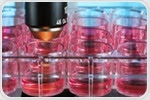|
| | August 29, 2018 | |
| | |
| | The latest life science microscopy news from AZoNetwork | |
|
|
 |
| |  Introducing Sona, the World’s Most Sensitive Back-illuminated sCMOS Introducing Sona, the World’s Most Sensitive Back-illuminated sCMOS
Sona is Andor’s latest high performance sCMOS camera platform, specifically for fluorescence microscopy. It launches with Sona 4.2B-11 and Sona 2.0B-11 back-illuminated sCMOS models, each featuring 95% Quantum Efficiency (QE) and market-leading vacuum cooling to -45 °C.
| |
|
|
|
|
 |
| |  In a revolutionary study, an LMU research team headed by Ralf Jungmann has shown that the application of chemically-modified DNA aptamers as protein markers enables one to improve the power of super-resolution fluorescence microscopy as an imaging instrument. In a revolutionary study, an LMU research team headed by Ralf Jungmann has shown that the application of chemically-modified DNA aptamers as protein markers enables one to improve the power of super-resolution fluorescence microscopy as an imaging instrument. | |
|
| |  Stimulated emission depletion (STED) microscopy is a super-resolution fluorescence microscopy technique which can overcome the diffraction limit. Conceptualized in 1990, it was six years later at the University of Turku that Stephen Hell and his colleagues developed STED microscopy. Stimulated emission depletion (STED) microscopy is a super-resolution fluorescence microscopy technique which can overcome the diffraction limit. Conceptualized in 1990, it was six years later at the University of Turku that Stephen Hell and his colleagues developed STED microscopy. | |
|
| |  Photoactivated Localization Microscopy (PALM) is a form of super-resolution fluorescence microscopy that is used in biological research. In 2014, The Nobel Prize for Chemistry was awarded to Eric Betzig, Stefan W. Hell, and William E. Moerner for the development of the super-resolved fluorescence microscopy. Photoactivated Localization Microscopy (PALM) is a form of super-resolution fluorescence microscopy that is used in biological research. In 2014, The Nobel Prize for Chemistry was awarded to Eric Betzig, Stefan W. Hell, and William E. Moerner for the development of the super-resolved fluorescence microscopy. | |
|
| |  ZEISS presents the initial release of its cloud-based digital microscopy platform, known under the name APEER at the Microscopy & Microanalysis conference in Baltimore, USA. Microscopy users will be able to automatically process images in the cloud by leveraging application workflows for 3D reconstructions, staining or segmenting. ZEISS presents the initial release of its cloud-based digital microscopy platform, known under the name APEER at the Microscopy & Microanalysis conference in Baltimore, USA. Microscopy users will be able to automatically process images in the cloud by leveraging application workflows for 3D reconstructions, staining or segmenting. | |
|
|
|
|





























.png)











No hay comentarios:
Publicar un comentario